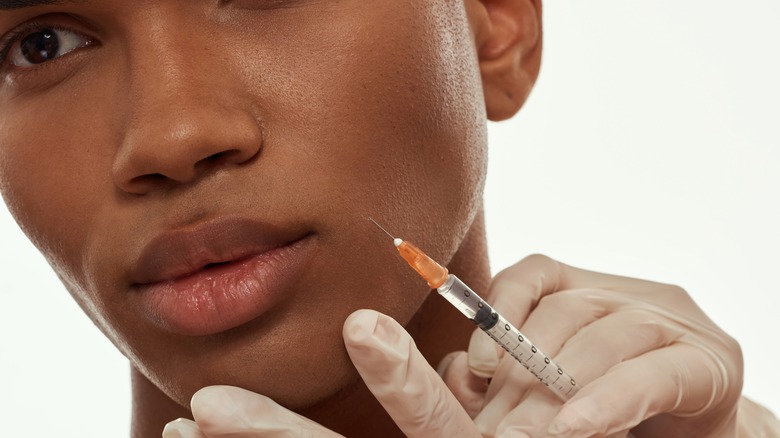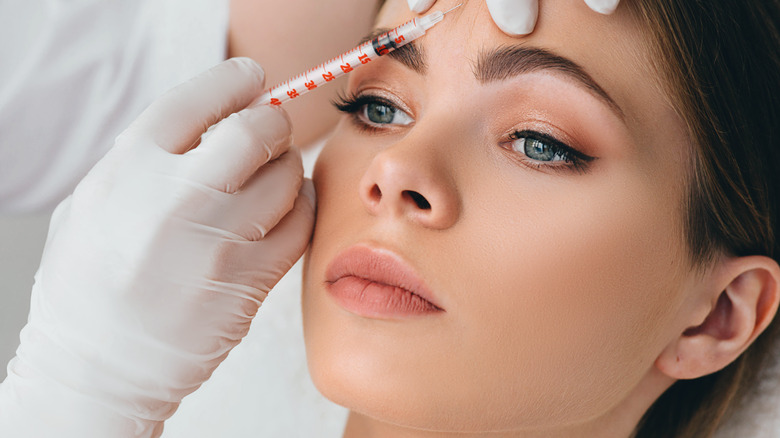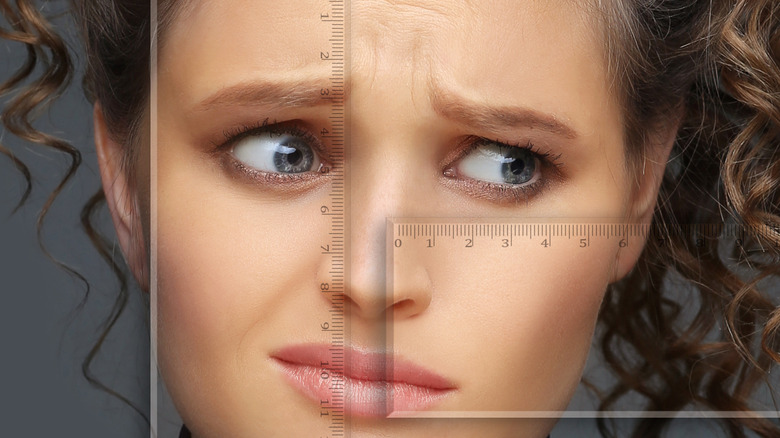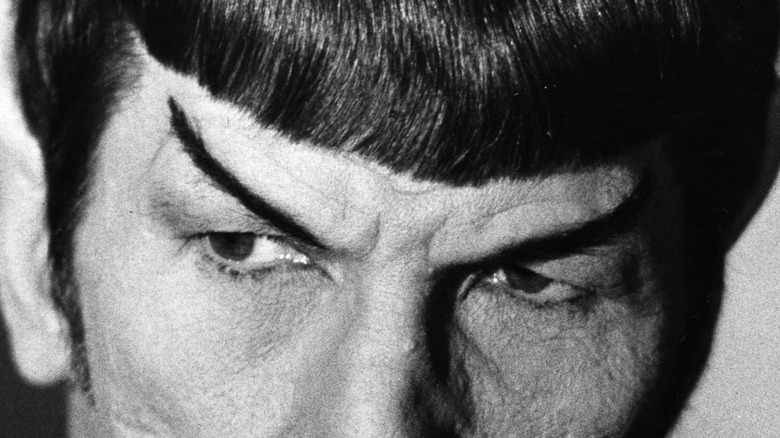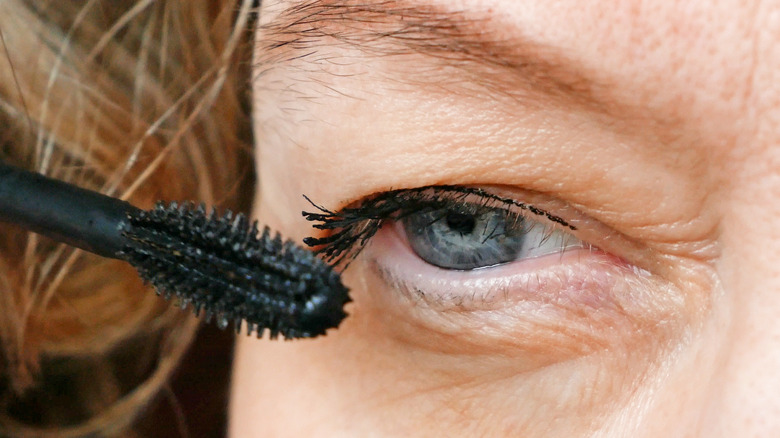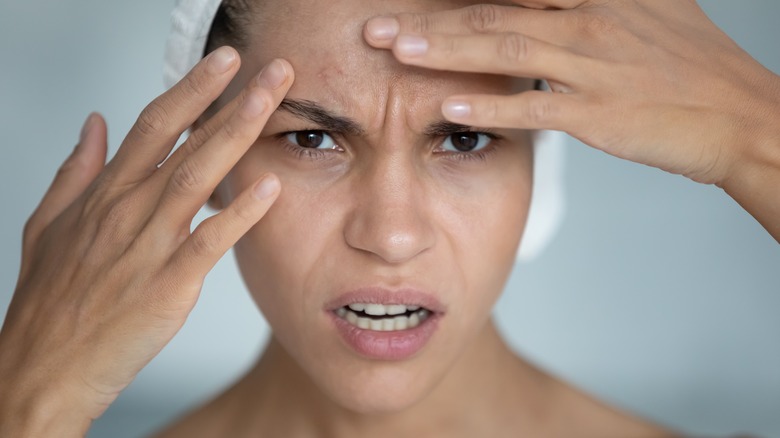Signs You've Gotten Too Much Botox
Though it can be used for cosmetic or medical purposes, Botox (botulinum toxin) is most widely known for its use to keep muscles from moving for cosmetic reasons. Per Healthline, what is known as preventative Botox is becoming more and more common for younger people and not just those looking to turn back the clock on aging after the fact. Using too much Botox or getting it done poorly, however, can affect the intended results — and your overall appearance.
Before or after getting Botox done, you might be left wondering just how much Botox is too much and how you can tell if you've ended up with too much of it. The Conversation notes that the desired look following Botox is one that appears to be natural, but that can sound pretty subjective. Luckily, there are plenty of resources to determine if you've gotten too much Botox injected, and we've rounded up some of the most common signs.
A frozen appearance is the most stereotypical sign
First up is what is perhaps the most stereotypical sign of having received too much Botox: Your facial muscles are or appear to be frozen because of the treatment you've received. On the blog for Dr. David Altamira, a board-certified plastic surgeon in Texas, it's explained that this can take on slightly different looks depending on where the Botox has been injected, whether that's around the eyebrows or elsewhere on the face. Generally speaking, a change in your facial expression beyond the desired results of the treatment is probably a cause for concern.
Arizona plastic surgeon Dr. Kelly Bomer commented to New Beauty on the subject of bad Botox, explaining, "My definition of 'Bad Botox' is a result that looks unnatural at rest or while moving. It is important to ask about retaining natural movement of brow elevation when actively raising the brow and normal cheek elevation when smiling."
Your face is suddenly asymmetrical
Another sign of having received too much Botox is if you have facial asymmetry that wasn't there before. In a blog post on the signs of bad Botox given by APT Injection Training, it's mentioned that this is generally the fault of the provider and not the patient themselves.
If this is the case for you, not all is lost. Dermatologist Dr. Dendy Engelman reported to Bustle that this issue can be fixed with relative ease, explaining, "Contrary to popular belief, botulinum toxin actually stops or limits muscle contraction, so it actually doesn't tighten muscles; it in fact does the exact opposite. So, if a muscle is still contracting after injection, leading to higher elevation of the brow on the stronger side, adding more into it will stop it from being so 'strong' and will allow for the brow to lower, leading to better symmetry."
You have Spock brows
Speaking of eyebrows, one of the signs of having received too much Botox is what is referred to as "Spock brows," making reference to the Vulcan character from the science fiction franchise "Star Trek" with the notoriously prominent eyebrows, most famously portrayed by actor Leonard Nimoy. Dermatologist Dr. Robyn Gmyrek told Charlotte's Book that this happens when more Botox is injected toward the center of the eyebrow and not at the tail, as also backed up by Singapore-based Dr. Rachel Ho on her eponymous blog.
Dr. Ho adds that Botox isn't the only cosmetic treatment that can create the Spock-brow effect; permanent makeup tattooed on the eyebrows, for instance, can also result in this undesired overarched look.
Per APT Injection Training, the so-called "Spock brow" isn't an issue that can be fixed immediately after injection, and patients will have to wait about two weeks from their injections to undergo corrections for it.
You have a drooping eyelid or eyelids
Another sign that you have received too much Botox is if you have a droopy eyelid or eyelids, which Heathline writes is also known as "ptosis." Healthline writes that this occurs when the Botox used migrates from where it was initially injected. On this subject, Dr. Robyn Gmyrek issued a word of caution to Charlotte's Book that providers should "never inject the area near the orbital bone right above the pupil" to keep this from happening. APT Injection Training writes that this can also occur when patients touch the injected area too soon after they've been injected, so it's best to keep your hands away from your face.
Unfortunately, like the Spock brow, there isn't a quick fix for ptosis that your provider can give you. Dr. Gmyrek noted that the drooping can last for months, which certainly makes it sound like one of the less ideal potential outcomes of undergoing cosmetic Botox.
You're not happy with your results overall
Last but not least, don't be afraid to trust your gut instincts when it comes to your health and appearance. You have gone to and paid a provider to achieve a desired effect, so they should be able to explain how the quantities of Botox that you've received and the locations in which you've received it will affect your appearance, both in the short term and long term. Healthgrades provides some important tips to keep in mind when choosing a provider, including making sure that they are certified where they are practicing to provide you with the treatments you're wanting to have done.
Surprisingly, Plastic surgeon Dr. Michelle Yagoda told HuffPost that some of the concerns that patients have with cosmetic Botox treatment can be because too little Botox was used on that part of their face. Said Yagoda, "Most people think they've had too much Botox when in fact they've had too little in a given area."
